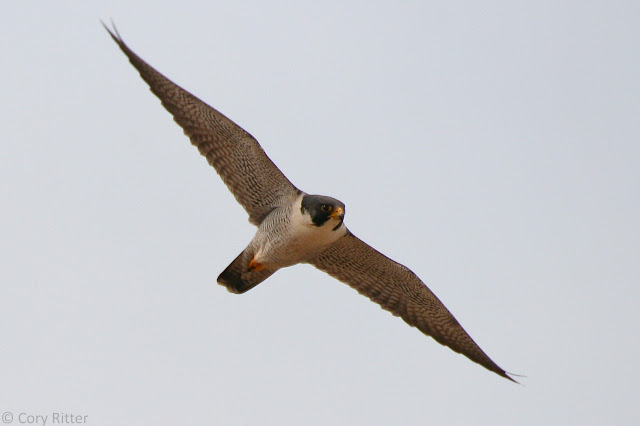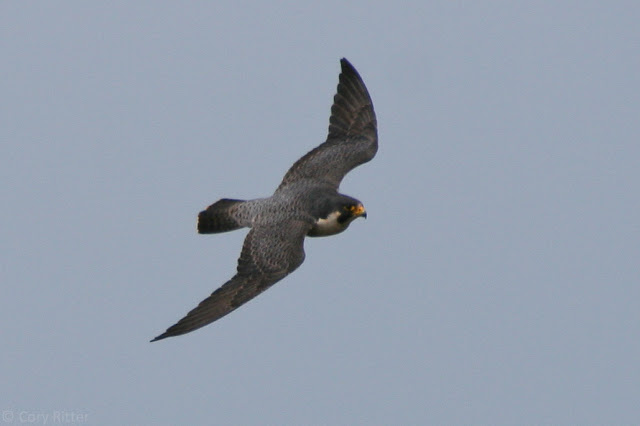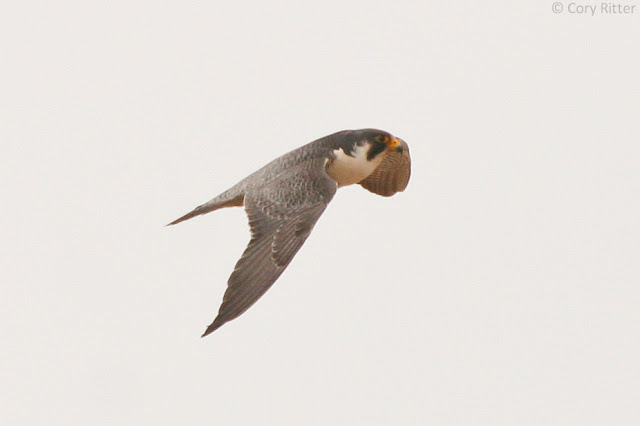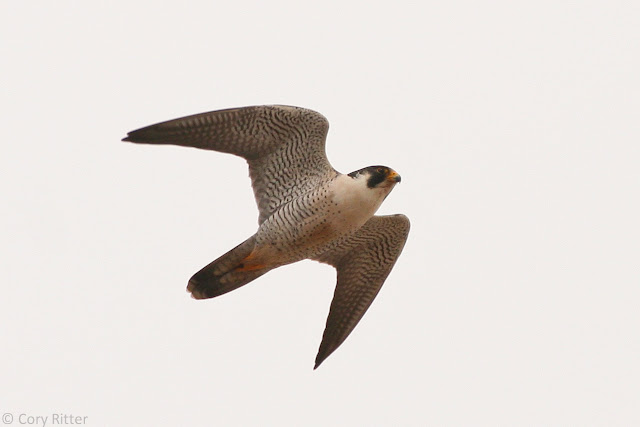Not really sure how late I am to the scene here but my friend Jim Tietz just informed me that our Little Bunting sight record from last fall on Southeast Farallon Island, a bird we got no photos of, but was definitely a Little Bunting passed the California Bird Records Committee in the first round! This was very unexpected because many if not most bird records committees are wary to accept a record of a review species without some sort of photo of audio documentation. Here are some excerpts from Jim's "Update to Rare Birds of California" of the birds we had that were reviewed (by the way I saw all of them!)
Thursday, June 27, 2013
Tuesday, June 25, 2013
Almost Paradise: Tortuguero
By Lukas Musher
This morning while checking nets at one of our sights in primary forest in Tortuguero, it hit me, this is pretty much as close to paradise as you can get. It began to rain lightly, and the duetting roars of both thunder and howler monkeys echoed around me. The nets were mostly empty except for an American Pygmy Kingfisher and a White-breasted Wood-Wren. While extracting the kingfisher, I tried not to flinch as the tiny pricks of mosquitoes drawing blood plagued my hands and face. As they gorged and I fiddled with the bird trying to figure out the secret to its removal, my mind went blank as I finally couldn't take the agitation any longer, letting go of the bird with one hand to slap the mosquitoes from my cheeks and neck. My hand returned to the bird, now with bright red stains and minuscule black lines that once were legs.
No, it wasn't perfect, or comfortable, or luxurious by any means, but there is something about this crazy place that has held a particularly special place in my heart (and in my brain; I find the tropics fascinating) since I first visited the tropical rainforest as a young teenager. Droplets of sweat, like condensation on a cold bottle of water, littered my forehead and upper lip. I breathed slowly, trying to block out the dizziness and slight headache from dehydration. I know it sounds horrible, but it truly is an amazing place.
Purple-throated Fruitcrows began calling above me. The female flew over and paused to stare with nesting material in her mouth – a life bird. Somewhere not too far away a Laughing Falcon began calling, guaco guaco guaco, over and over. Tiny poison dart frogs, bright red with blue hind legs (called bluejeans frogs) jolted spasmodically over the leaf-covered forest floor. Finally the bird was out. I put it in one of our cloth bags and tied the draw string, then returned to the banding station.
Since I got to Tortuguero 5 days ago I've seen and done a lot. Although it rains a lot, and I haven't been able to get too many photos, we've caught all kinds of interesting species, and seen some cool birds. Gartered and Slaty-tailed Trogons, Keel-billed and Black-mandabled Toucans, Mealy and Red-lored Parrots, Black-cowled Oriole, and lots of other species have been seen regularly. On the boat ride here we saw an adult and juvenal King Vulture.
 |
| American Pygmy Kingfisher, Tortuga Lodge, Tortuguero, Costa Rica |
 |
| Wedge-billed Woodcreeper, Tortuga Lodge, Tortuguero, Costa Rica |
Purple-throated Fruitcrows began calling above me. The female flew over and paused to stare with nesting material in her mouth – a life bird. Somewhere not too far away a Laughing Falcon began calling, guaco guaco guaco, over and over. Tiny poison dart frogs, bright red with blue hind legs (called bluejeans frogs) jolted spasmodically over the leaf-covered forest floor. Finally the bird was out. I put it in one of our cloth bags and tied the draw string, then returned to the banding station.
 |
| Female Purple-crowned Woodnymph, Tortuguero National Park, Tortuguero, Costa Rica (iPhone photo) |
 |
| Juvenal Bare-throated Tiger-Heron, Caribbean Conservation Corporation, Tortuguero, Costa Rica |
 |
| Pale-vented Pigeon, Caribbean Conservation Corporation, Tortuguero, Costa Rica |
Monday, June 24, 2013
Tricolored Heron Visits Wisconsin
I just arrived back to southern Wisconsin, where I'll be spending the summer, and the timing couldn't have been any better. A Tricolored Heron has been hanging around Findlay VPA just southeast of Fort Atkinson in Jefferson County--which is only a 45 minute drive from my home.
"What is a VPA?" you might ask. VPA stands for Voluntary Public Access, and is a program where landowners allow public access to their land for recreational purposes in return for financial incentives.
I made my way out to Findlay VPA around mid-day on Sunday. The two spots mentioned on the listserv produced some quality birds including Dickcissel, Bobolink, Grasshopper, Savannah and Song Sparrow, Eastern Meadowlark, House Wren, Tree and Barn Swallow, Great Blue Heron, American Robin, and Red-winged Blackbird. It wasn't until a couple hours later, when I ran into fellow birders Nancy and Patrick, that we located the Tricolored Heron--and it was certainly worth the wait!
 |
| Tricolored Heron, Vindlay VPA, Jefferson County, Wisconsin |
 |
| Tricolored Heron with Blue-winged Teal, Vindlay VPA, Jefferson County, WI |
Saturday, June 22, 2013
PEFAntastic!
By Cory Ritter
Whitefish Point might be known for its Rough-legged Hawks, but this year it was the spring of the Peregrine Falcon. In fact, we set the all-time season high count for peregrines with 76, beating the previous record of 73 set in 2005. As I was saying, birders don't come to Whitefish Point to see peregrines, as other sites can easily see 76 in a day--or an hour if you're in the Florida Keys. However, it is exactly this scarcity that makes peregrines so exciting here at the point.
That all being said, enjoy the photos.
Oh, did I mention we get mostly adults here in the spring?
Whitefish Point might be known for its Rough-legged Hawks, but this year it was the spring of the Peregrine Falcon. In fact, we set the all-time season high count for peregrines with 76, beating the previous record of 73 set in 2005. As I was saying, birders don't come to Whitefish Point to see peregrines, as other sites can easily see 76 in a day--or an hour if you're in the Florida Keys. However, it is exactly this scarcity that makes peregrines so exciting here at the point.
That all being said, enjoy the photos.
Oh, did I mention we get mostly adults here in the spring?
Wednesday, June 19, 2013
Costa Rica: The Talamanca Highlands
By Lukas Musher
I just got back (though still in Costa Rica) from two-and-a-half weeks in the Talamanca Highlands banding resident landbirds. We didn't have internet most of the time so I never had a chance to post about all the great stuff I was seeing and catching.
To start, I was living on a finca consisting of hundreds of acres of primary and secondary cloud forest, a dairy farm, and three small lakes. Needless to say I kept myself busy birding and banding, (and sleeping, waking up early is rough, ok...).
One of the interesting things about the Central Cordillera of Central America is the large number of northern or temperate taxa that inhabit the highlands. Many of these species evolved from species that were able to disperse south during cold periods in earth's history. Examples of temperate taxa that call the Costa Rican highlands their home include Contopus (pewees; Ochraceous Pewee), Selasphorus (genus of hummingbirds; e.g. Volcano Hummingbird), Empidonax (genus of Tyrant Flycatchers; e.g. Black-capped Flycatcher), and Catharus (genus of Thrushes; e.g. Black-billed Nightingale Thrush). Furthermore, the fact that the Costa Rican highlands, along with those of western Panama are well separated from other highlands in Latin America, allowed for speciation to occur in many taxa, meaning many endemic species to Costa Rica and western Panama.
Here is a complete list of birds seen and/or banded during my 18-day stint at CRBO Madre Selva, 2500 meters (>1.5mi) high in the Central Cordillera of Costa Rica:
Least Grebe
Black Guan (endemic to CR and western Panama)
Spotted Wood-Quail
Black Vulture
Turkey Vulture
Swallow-tailed Kite
Short-tailed Hawk
Red-tailed Hawk
Ornate Hawk-Eagle (Quite rare in the highlands and a super lucky find by Sara, my banding partner. It flew into a tree at our banding site and stuck around for less than a minute before taking off again.)
Barred Forest Falcon (In the hand, sweet)
Band-tailed Pigeon
Ruddy Pigeon (In the Primary Forest at Tapanti National Park)
Bare-shanked Screech-Owl (Endemic to CR and western Panama)
White-collared Swift
Fiery-throated Hummingbird (endemic to CR and W Panama)
Magnificent Hummingbird
 |
| Barred Becard, Madre Selva, Talamanca Highlands, Costa Rica |
To start, I was living on a finca consisting of hundreds of acres of primary and secondary cloud forest, a dairy farm, and three small lakes. Needless to say I kept myself busy birding and banding, (and sleeping, waking up early is rough, ok...).
One of the interesting things about the Central Cordillera of Central America is the large number of northern or temperate taxa that inhabit the highlands. Many of these species evolved from species that were able to disperse south during cold periods in earth's history. Examples of temperate taxa that call the Costa Rican highlands their home include Contopus (pewees; Ochraceous Pewee), Selasphorus (genus of hummingbirds; e.g. Volcano Hummingbird), Empidonax (genus of Tyrant Flycatchers; e.g. Black-capped Flycatcher), and Catharus (genus of Thrushes; e.g. Black-billed Nightingale Thrush). Furthermore, the fact that the Costa Rican highlands, along with those of western Panama are well separated from other highlands in Latin America, allowed for speciation to occur in many taxa, meaning many endemic species to Costa Rica and western Panama.
Here is a complete list of birds seen and/or banded during my 18-day stint at CRBO Madre Selva, 2500 meters (>1.5mi) high in the Central Cordillera of Costa Rica:
Least Grebe
Black Guan (endemic to CR and western Panama)
Spotted Wood-Quail
Black Vulture
Turkey Vulture
Swallow-tailed Kite
Short-tailed Hawk
Red-tailed Hawk
Ornate Hawk-Eagle (Quite rare in the highlands and a super lucky find by Sara, my banding partner. It flew into a tree at our banding site and stuck around for less than a minute before taking off again.)
Barred Forest Falcon (In the hand, sweet)
 |
| Barred Forest-Falcon |
Ruddy Pigeon (In the Primary Forest at Tapanti National Park)
Bare-shanked Screech-Owl (Endemic to CR and western Panama)
White-collared Swift
Fiery-throated Hummingbird (endemic to CR and W Panama)
Magnificent Hummingbird
 |
| Magnificent Hummingbird |
Green-fronted Lancebill
 |
| Green-fronted Lancebill |
White-throated Mountain-Gem (Endemic to CR and W Panama)
Volcano Hummingbird (Endemic to CR and W Panama)
Collared Trogon
 |
| Collared Trogon |
Resplendent Quetzal
Acorn Woodpecker
Hairy Woodpecker
Red-faced Spinetail
Ruddy Treerunner (Endemic to CR and W Panama)
Buffy Tuftedcheek
Spot-crowned Woodcreeper
 |
| Spot-crowned Woodcreeper |
Silvery-fronted Tapaculo (endemic to CR and W panama; heard only in Tapanti)
Paltry Tyrannulet (a common bird in CR but super rare in Madre Selva)
 |
| Paltry Tyrannulet |
Mountain Elaenia
Olive-striped Flycatcher
Torrent Tyrannulet
Yellowish Flycatcher
Black-capped Flycatcher (Endemic to CR and W Panama)
 |
| Black-capped Flycatcher |
Black Phoebe
Great Kiskadee
Tropical Kingbird
Barred Becard
Brown-capped Vireo
Yellow-winged Vireo (endemic from CR to W Panama)
Blue-and-white Swallow
Ochraceous Wren (endemic to CR and W Panama)
House Wren
Gray-breasted Wood-Wren
Black-billed Nightingale-Thrush (endemic to CR and W Panama)
 |
| Black-billed Nightingale Thrush |
Ruddy-capped Nightingale-Thrush
Black-faced Solitaire (endemic to CR and W Panama)
 |
| Black-faced Solitaire |
Clay-colored Thrush
Mountain Thrush
Long-tailed Silky-Flycatcher (endemic to CR and W Panama)
 |
| Long-tailed Silky-Flycatcher |
Black-and-yellow Silky-Flycatcher (endemic to CR and W Panama)
 |
| Black-and-yellow Silky-Flycatcher |
Flame-throated Warbler (endemic to CR and W Panama)
Collared Redstart (endemic to CR and W Panama)
 |
| Collared Redstart |
Black-cheeked Warbler (endemic to CR and W Panama)
Common Bush-Tanager
Sooty-capped Bush-Tanager (endemic to CR and W Panama)
 |
| Juvenal and Adult Sooty-capped Bush-Tanagers |
Flame-colored Tanager
Spangle-cheeked Tanager (endemic to CR and W Panama)
 |
| Spangle-cheeked Tanager |
Slaty Finch
Large-footed Finch (endemic to CR and W Panama)
White-naped Brush-Finch
 |
| White-naped Brush-Finch |
Yellow-thighed Finch (endemic to CR and W Panama)
Chestnut-capped Brush-Finch
Rufous-collared Sparrow
 |
| Juvenal Rufous-collared Sparrow |
Black-thighed Grosbeak (endemic to CR and W Panama)
 |
| Black-thighed Grosbeak |
Bronzed Cowbird
Golden-browed Chlorophonia (heard only...damn)
 |
| This is just a species of Lizard that was everywhere. No idea what it is though. |
Subscribe to:
Posts (Atom)






.JPG)



















